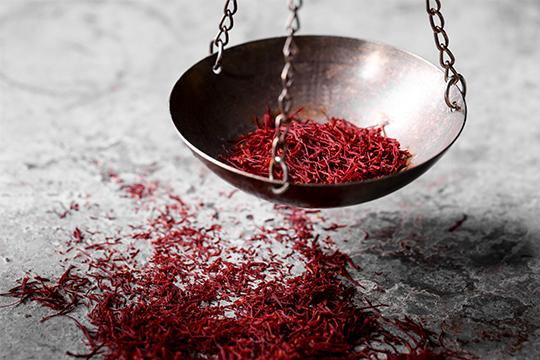The Amazing Benefits of Saffron
The Million Dollar Spice Saffron, the royalty of all species is the most expensive spice besides truffles is harvested by meticulously picking the petals of the crocus sativus flower. The crimson red petals cultivated for over 3500 years and traded across continents. The Greeks, Indian, the Romans, and the Egyptians knew and used saffron for everything ranging from cooking, beauty, healing, and as cosmetics. The saffron spice is very expensive, an ounce cost more than $500, and you might be wondering why it is this expensive.

Do you know that to produce one pound of saffron (453grams), the petals of 80,000 flowers are picked, this back-breaking work makes it very pricey. A pound of saffron cost 600 to 2000 dollars making it more expensive than gold in the commodity market.
The used of saffron are numerous; history has it that Cleopatra bath with it to get that golden glow on her skin, the Romans used it as deodorants, the Indians used it and still use it for cooking, making drinks or as medicinal properties to cure ailments such as digestive/stomach disorder.
Characteristic of Pure Saffron
The expensive nature of saffron is known by its taste (pure aroma smell sweet but does not taste sweet). Pure saffron has the aroma of honey mixed with hay; it has an earthy aroma and retains its bright color when placed in water. The major saffron test is the baking soda test; pure saffron turns baking soda paste to yellow while fake saffron gives it a dull red color.

Benefits of Saffron
Oh my goodness, if there is a spice with a million property, then saffron is the one. The power-packed herb has not been extensively studied but saffron is used for the color and aroma in food alongside it numerous health benefits.
Scientists have discovered that saffron is composed of 150 volatile bioactive compounds including carotenoids, safranal, crocin, numerous antioxidants, and biochemical with vitamins and minerals that are important to our health. These bioactive compounds of saffron make them an excellent cure for depression, late or delayed menstruation in puberty, stomach disorder, diabetes, and are very good for your heart. Saffron is also good for your skin, hair, eyes, and bones but we are going to see some health benefit of saffron in other areas such as:

- Treatment for cancer
The American cancer society has found that cancerous rats treated with saffron extracts showed relative improvements in their healing and reduction of the cancer growth. The crocin in saffron inhibited the growth of colorectal cancer cells and didn’t affect the healthy cell. This shows that saffron can be used to treat and cure prostate cancer, breast cancer, leukemia, and skin cancer. Another study shows that the purified compound crocetin has a high potential of not only inhibiting pancreatic cancer but obstructing the cancer stem cells by destroying them completely, preventing cancer from coming back. - Prepares you for labor
A study showed that women that took saffron during pregnancy had their cervix ready for the birthing process by shortening and softens the uterine cervix ready for the baby. Women who took saffron also had more chances of having a natural birth rather than cesarean sections. However, reports also show that saffron is also used in terminating pregnancies, so please seek a doctor’s advice before you indulge in it. - Restoring vision
A Spanish study shows that saffron can prevent vision and retinal degeneration. Safranal, a compound in saffron was found to preserve photoreceptor mechanism that helps your eyes see well by enhancing your vision response and the capillary network of the eyes. Another study from Sydney shows that elderly patients with vision impairment had improved vision after taking saffron pills. Scientists are also looking at saffron for the cure of retinitisc pigmentosa, a genetic disease that causes permanent vision loss in young people.
The million dollar spice, saffron is worth it for all the property that it possesses. Several studies are still ongoing to discover the depth of the healing property of saffron and how we can harness the medicinal benefits from the Crocus sativus flower.
Medical Disclaimer
All content found on the Nicesaffron.com Website, including: text, images, audio, or other formats were created for informational purposes only. Offerings for continuing education credits are clearly identified and the appropriate target audience is identified. The Content is not intended to be a substitute for professional medical advice, diagnosis, or treatment. Always seek the advice of your physician or other qualified health provider with any questions you may have regarding a medical condition. Never disregard professional medical advice or delay in seeking it because of something you have read on this Website.
If you think you may have a medical emergency, call your doctor, go to the emergency department, or call 911 immediately. nicesaffron.com does not recommend or endorse any specific tests, physicians, products, procedures, opinions, or other information that may be mentioned on Dannemiller.com. Reliance on any information provided by Dannemiller.com, nicesaffron.com employees, contracted writers, or medical professionals presenting content for publication to nicesaffron.com is solely at your own risk.
The Site may contain health- or medical-related materials or discussions regarding sexually explicit disease states. If you find these materials offensive, you may not want to use our Site. The Site and its Content are provided on an "as is" basis.
Links to educational content not created by nicesaffron.com are taken at your own risk. nicesaffron.com is not responsible for the claims of external websites and education companies.


